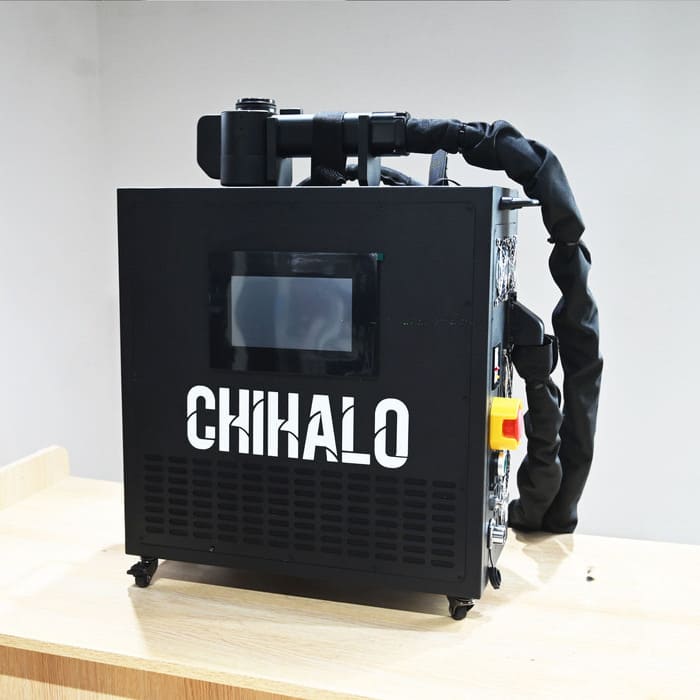Laser Cleaning Machine for Wood: Your Complete Selection and Operation Guide 2025
Laser cleaning machines for wood have revolutionized surface restoration and paint removal processes. Whether you’re restoring antique furniture or handling industrial wood processing, choosing the right laser cleaning machine is crucial for optimal results.
Table of Contents
1. What is a Laser Cleaning Machine for Wood?
A laser cleaning machine for wood utilizes focused laser beams to remove paint, rust, oxidation, and contaminants from wood surfaces without damaging the underlying material. This technology works by vaporizing unwanted layers while preserving the wood’s natural grain and texture.
How Laser Wood Cleaning Works?
The laser cleaning process operates through controlled ablation. When the laser beam contacts the painted or contaminated surface, it heats the material to vaporization point. The intense energy selectively targets paint layers, coatings, and debris while the wood beneath remains unaffected due to different absorption rates.
Benefits Over Traditional Methods
Laser cleaning machines offer significant advantages over chemical strippers and mechanical sanding:
- Precision control – Exact targeting without surface damage
- Eco-friendly operation – No chemical waste or toxic fumes
- Time efficiency – Faster processing than traditional methods
- Versatile applications – Works on various wood types and surface conditions
- Cost-effective – Reduced labor and material costs over time
2. Types of Laser Cleaning Machines for Wood
Understanding different laser technologies helps you select the most suitable equipment for your wood cleaning projects. Three main types of fiber laser systems dominate the market, each offering unique advantages for specific applications.
CW Fiber Laser Cleaners for Wood
Continuous Wave (CW) fiber laser cleaners deliver steady, uninterrupted laser energy for consistent cleaning performance.But usually it has high power more than 1KW, so its heat will burn the wood surface. Also its energy is not enough to remove wood paint in most of the situations.
Pulse Fiber Laser Cleaner for Wood
Pulse fiber laser cleaners emit laser energy in controlled bursts, offering superior precision for delicate wood restoration work. While most of the pulse laser cleaners don’t have a widely range of frequency, so it gets some limiations in adjustment.
MOPA Fiber Laser Cleaner for Wood
Master Oscillator Power Amplifier (MOPA) fiber laser cleaners represent the most advanced technology available for wood cleaning applications. MOPA systems offer adjustable pulse width and frequency parameters, providing unprecedented control over the cleaning process.
Suitable Laser Cleaning Machine for Wood
3. Choosing the Right Laser Power for Wood
Selecting appropriate laser power ensures effective cleaning without wood damage. Power requirements vary based on coating thickness, wood type, and project scope.
200W systems work well for light paint removal and surface cleaning on softwoods and thin coatings. These machines offer good precision for detailed work and are cost-effective for small to medium projects. Air-cooled 200W units provide adequate performance for most furniture restoration tasks.
Higher power systems handle thicker paint layers, multiple coatings, and harder wood species more efficiently. 500W pulse laser cleaning machines can process larger areas quickly while maintaining precision control. These systems often feature water-cooling for continuous operation.
4. Safe Operation of Wood Laser Cleaning Machines
Proper safety procedures protect operators and ensure optimal results when using laser cleaning equipment.
Essential safety gear includes:
- Laser safety glasses – Wavelength-specific protection required
- Respiratory protection – Filter masks for vapor and particles
- Protective clothing – Fire-resistant materials recommended
- Adequate ventilation – Fume extraction systems for enclosed spaces
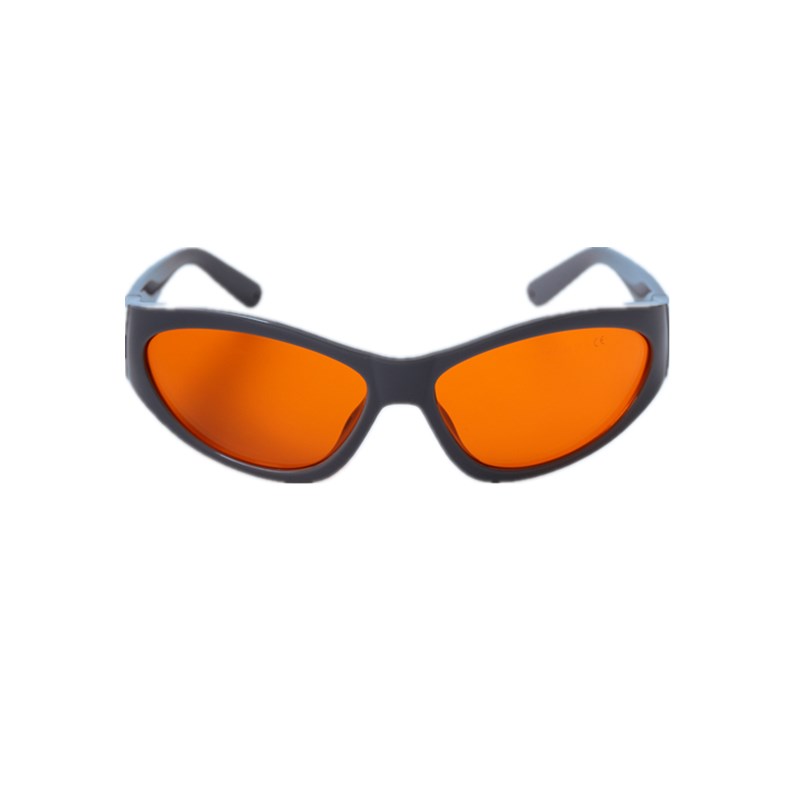
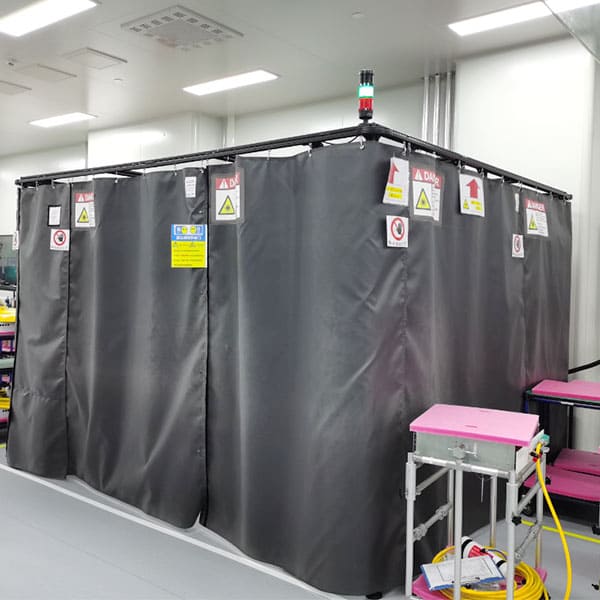

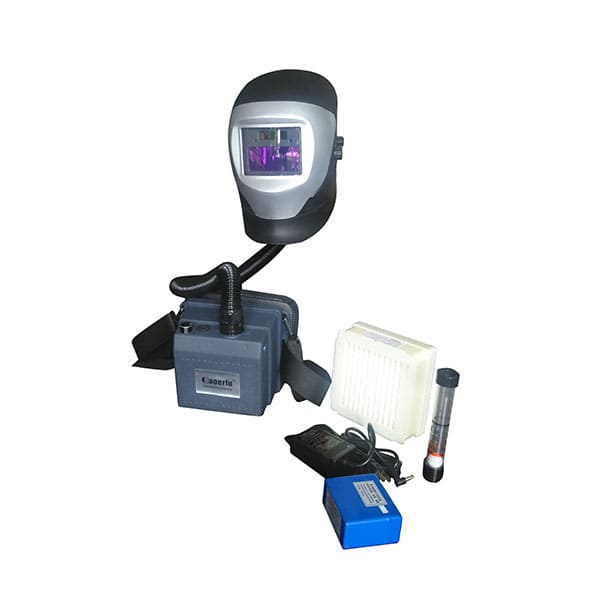
Prevent wood damage by:
- Starting with lower power settings
- Maintaining proper beam focus
- Using multiple light passes instead of single heavy passes
- Monitoring surface temperature
- Allowing cooling time between passes
5. Comparative Analysis: Laser vs. Traditional Paint Removal Methods
The process of removing paint from wood surfaces has evolved significantly over the years, with laser technology emerging as a cutting-edge alternative to traditional methods. Each approach has its advantages and disadvantages, and understanding these can help determine the best method for a specific project.
Pros and Cons of Each Method
Traditional Methods:
- Chemical Strippers: These are effective for removing multiple layers of paint but can be messy and require significant cleanup. The chemicals used are often toxic, posing health and environmental risks.
- Sanding: This method is straightforward and doesn’t involve chemicals, but it’s labor-intensive and generates a lot of dust. Sanding can also damage the wood if not done carefully.
- Heat Guns: Heat guns can quickly lift paint from wood, but there’s a risk of scorching the wood or causing a fire if the heat is applied too long in one spot.
Pros:
- Often cheaper in terms of initial setup.
- Widely available and familiar to most users.
Cons:
- Can be messy and hazardous to health and the environment.
- Risk of damaging the wood.
- Time-consuming and labor-intensive.
Laser Paint Removal from Wood:
Laser technology uses focused light beams to vaporize or detach paint from wood surfaces without direct contact, minimizing damage to the wood.
Pros:
- High precision and control, allow for detailed work without damaging the wood.
- Environmentally friendly, with no need for chemicals and minimal waste.
- Efficient and fast, especially for complex or delicate surfaces.
- Safer for the operator when proper safety gear is used, with reduced exposure to toxic substances.
Cons:
- The higher initial cost for equipment.
- Requires training and knowledge to operate safely and effectively.
- Not as widely available as traditional methods.
Why Laser Technology is Superior for Wood Paint Removal?
Laser technology offers several unique advantages that make it superior for specific applications:
Precision and Quality: Lasers can precisely target the paint without affecting the underlying wood, preserving the integrity and appearance of the wood grain. This makes the laser technology ideal for restoring valuable or antique wood items where maintaining the original material is crucial.
Efficiency: Laser paint removal is significantly faster than manual methods, especially on complex shapes or intricate designs. This efficiency can save considerable time and labor costs on large-scale or detailed projects.
Safety and Environmental Impact: Unlike chemical strippers, laser removal doesn’t involve toxic substances, making it safer for the user and better for the environment. This aspect is particularly important in enclosed spaces or areas with poor ventilation.
Versatility: Lasers can be adjusted to remove different types of paint and finishes from various materials, not just wood. This versatility makes them invaluable for professionals who work with a range of materials and coatings.
6. Common Applications for Wood Laser Cleaning
Laser cleaning machines serve diverse applications across industries and project types.
Furniture Restoration
Antique furniture restoration benefits greatly from laser precision. The technology can remove multiple paint layers while preserving original wood grain and carved details. Delicate surfaces that would be damaged by sanding respond well to controlled laser cleaning.
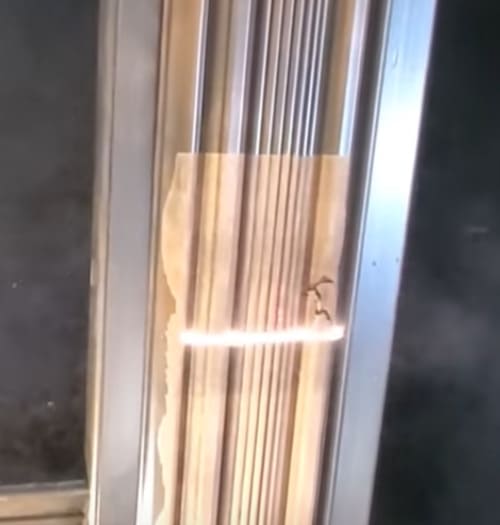
Paint and Varnish Removal
Both water-based and oil-based paints can be effectively removed using appropriate laser settings. Old varnish layers that resist chemical strippers often yield easily to laser treatment. The process works particularly well on vertical surfaces where chemicals tend to run.
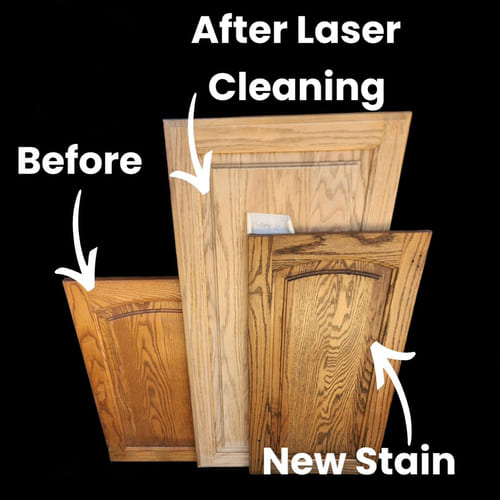
Industrial Wood Processing
Manufacturing facilities use laser cleaning for:
- Preparing surfaces for new coatings
- Removing processing residues
- Cleaning molds and tooling
- Quality control applications
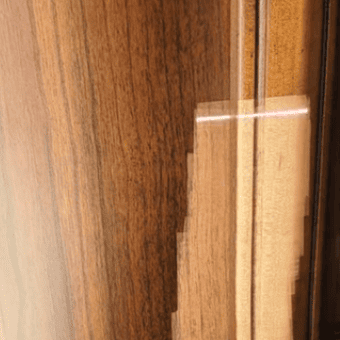
7. Maintenance and Care for Laser-Equipped Machinery
Daily Maintenance Routines
Regular cleaning tasks include:
- Wiping down optics with lint-free cloths
- Checking beam alignment
- Inspecting cooling systems
- Verifying safety interlocks
- Cleaning debris from work area
Extending Equipment Lifespan
Key maintenance practices:
- Follow manufacturer’s service schedules
- Use quality consumables and replacement parts
- Maintain stable operating environment
- Train operators on proper techniques
- Keep detailed maintenance records
Troubleshooting Common Issues
Common problems and solutions:
- Reduced cleaning efficiency – Check optics cleanliness and alignment
- Inconsistent results – Verify power settings and focus distance
- Overheating – Inspect cooling system operation
- Safety system faults – Review interlock connections and sensors
8. Cost Analysis: Investing in Laser Technology for Paint Removal from Wood
The decision to invest in laser technology for paint removal involves a comprehensive analysis of the initial costs against the long-term savings and benefits. This technology, known for its efficiency, precision, and eco-friendliness, also presents an economic argument, especially for small businesses looking to optimize their operations. Let’s explore the financial implications of adopting laser technology for paint removal tasks.
Initial Investment vs. Long-Term Savings
Initial Investment:
- Equipment Cost: The upfront cost of purchasing laser equipment is the most significant investment. The price can vary widely depending on the type (e.g., CO2, fiber, Nd:YAG), power, brand, and additional features. High-quality laser systems can be a substantial financial commitment.
- Training and Setup: Proper training for operators and any necessary setup adjustments or installations represent additional initial costs. Ensuring that staff are fully trained is crucial for maximizing the efficiency and lifespan of the equipment.
- Safety and Ventilation: Investing in appropriate safety gear for operators and potentially upgrading the ventilation system in the facility to handle the fumes and particles produced during paint removal.
Long-Term Savings:
- Reduced Material and Disposal Costs: Laser paint removal minimizes the need for consumables such as chemicals and sandpaper and reduces the amount of waste produced, thereby lowering ongoing material and disposal costs.
- Efficiency Gains: Lasers can remove paint much faster and with greater precision than traditional methods, leading to significant savings in labor costs and time. This efficiency can increase throughput and allow businesses to take on more projects.
- Maintenance and Durability: Modern laser systems are designed for longevity and require relatively low maintenance compared to mechanical or chemical paint removal systems, translating to lower long-term operational costs.
- Environmental Compliance: By avoiding chemical strippers and reducing waste, businesses may also find savings in compliance with environmental regulations, potentially avoiding fines and benefiting from incentives for eco-friendly practices.
Cost-Benefit Analysis for Small Businesses
For small businesses, the decision to invest in laser technology hinges on a careful cost-benefit analysis. While the initial investment is substantial, the long-term benefits—ranging from operational efficiencies to environmental compliance—can justify the expense.
Break-Even Analysis: Calculate the point at which the savings in labor, materials, and disposal costs will cover the initial investment. For many businesses, the break-even point can be reached within a few years, after which the technology provides net savings.
Comparative Analysis: Consider the costs and inefficiencies associated with current paint removal methods. Include labor hours, material costs, waste disposal fees, and any potential fines or compliance issues.
Growth Opportunities: Assess how laser technology could enable your business to expand its services or improve turnaround times, potentially opening up new revenue streams or market segments.
Sustainability and Branding: Don’t overlook the value of adopting environmentally friendly technologies. This can enhance your brand’s reputation, appeal to clients who prioritize sustainability, and possibly qualify your business for green incentives.
9. Future Trends in Laser Paint Removal Technology
As we look ahead, the field of laser paint removal technology is poised for significant advancements and innovations. Driven by increasing demands for efficiency, sustainability, and precision, the next decade is expected to bring groundbreaking changes to how lasers are used for paint removal. Here’s an insight into the innovations and technological advances that are likely to shape the future of this industry.
Innovations and Technological Advances
Increased Efficiency and Power: Ongoing research and development are expected to produce laser systems that are more powerful yet energy-efficient. These advancements will allow for faster paint removal over larger areas, making the technology more applicable to industrial-scale projects.
Enhanced Precision and Control: Future laser systems will offer even greater precision, with advancements in beam shaping and control technology. This will allow for the selective removal of paint without affecting underlying materials, even on a microscopic level, opening up new applications in conservation and restoration work.
Improved Safety Features: As laser technology becomes more powerful, the emphasis on safety will grow. Innovations may include advanced monitoring systems that can automatically adjust power levels or shut down the equipment if unsafe conditions are detected.
Integration with AI and Robotics: The integration of artificial intelligence (AI) and robotics with laser paint removal systems is on the horizon. AI could optimize the removal process by automatically adjusting settings in real time for different paint types and conditions. Meanwhile, robotics could enable fully automated paint removal, reducing the need for manual operation and enhancing safety.
Portable and Affordable Systems: Technological advancements are expected to lead to the development of more compact, portable laser systems at lower price points. This will make laser paint removal technology accessible to a broader range of users, including small businesses and DIY enthusiasts.
Eco-friendly Solutions: As environmental regulations become stricter, the demand for green technologies will drive innovations in laser paint removal. Future systems may feature even lower energy consumption and the ability to capture and recycle vaporized materials, minimizing environmental impact.
Predictions for the Next Decade
Widespread Adoption: The benefits of laser paint removal, coupled with technological advances, will lead to its widespread adoption across various industries, including automotive, aerospace, and manufacturing.
Regulatory Support: Governments and regulatory bodies may begin to support the use of laser paint removal technology through incentives and regulations, especially as a means to reduce chemical waste and improve workplace safety.
Customization and Specialization: We may see the development of specialized laser systems designed for specific applications, materials, or industries, offering customized solutions that are highly efficient and effective for particular needs.
Global Market Expansion: As the technology becomes more accessible and affordable, its adoption is likely to expand globally, especially in emerging markets that are currently adopting more traditional paint removal methods.
The future of laser paint removal technology is bright, with innovations that promise to make the process faster, safer, and more environmentally friendly. As these technologies evolve, they will not only enhance the capabilities of laser paint removal but also expand its applications, making it an indispensable tool in more fields than ever before.
F.A.Q.
A laser cleaning machine for wood uses focused laser energy to remove paint, coatings, rust, and contaminants from wood surfaces without damaging the underlying material. The technology works by vaporizing unwanted layers while preserving the wood's natural grain and texture.
Pulse laser cleaners emit short bursts of concentrated laser energy that heat surface contaminants to vaporization point. This controlled process removes paint and debris while the wood beneath remains unaffected due to different material absorption rates.
Pulse lasers deliver energy in short bursts, making them ideal for delicate control and preventing heat buildup. Fiber lasers provide continuous beam operation with excellent precision. Both can be effective for wood cleaning depending on the specific application requirements.
Laser cleaning offers superior precision, eliminates toxic chemicals, reduces waste, and works faster on complex surfaces. While initial equipment costs are higher, laser technology provides better long-term value through reduced labor and material expenses.
Yes, laser cleaning typically proves more effective for precision work, complex shapes, and multi-layer paint removal. The technology offers better control, consistent results, and environmental benefits compared to chemical or mechanical alternatives.
Yes, handheld laser cleaning machines work excellently on wood surfaces. These portable units offer flexibility for furniture restoration, detailed work, and areas with limited access. Most handheld systems provide sufficient power for typical wood cleaning applications.
Fiber laser cleaners offer precise beam control, consistent power output, and wavelengths that effectively target paint and coatings while minimizing wood absorption. Their compact design and reliability make them ideal for professional wood restoration work.
Air-cooled pulse laser cleaning machines work well for wood applications, especially intermittent use projects. These systems provide adequate cooling for most wood cleaning tasks while offering easier setup and lower maintenance requirements than water-cooled alternatives.
Power selection depends on your specific needs: 200W systems work well for light coatings and detailed work, 300W units handle most general applications efficiently, while 500W systems excel at heavy-duty tasks and thick paint layers. Consider your typical project requirements when choosing.
Properly operated laser cleaning machines will not damage wood surfaces. The key is using appropriate power settings, maintaining correct focus distance, and selecting suitable wavelengths for the specific wood type and surface condition.
No, laser cleaning preserves delicate wood textures when operated correctly. The precision control allows selective removal of contaminants while protecting underlying wood grain and surface details that would be damaged by sanding or aggressive chemical treatment.
Laser paint removal can be safely used on most wood types with proper parameter adjustment. Softwoods and hardwoods require different settings, and exotic woods may need careful testing. The technology's precision makes it suitable for valuable and delicate wood species
Most common wood species work well with laser cleaning including oak, maple, pine, cedar, and walnut. Hardwoods typically handle laser cleaning excellently, while softwoods require more careful parameter control. Exotic woods should be tested before full application.
Yes, laser cleaning is particularly valuable for antique furniture restoration because of its precision and non-invasive nature. The technology can remove paint layers while preserving original wood grain, carved details, and patina that would be destroyed by traditional methods.
Essential safety measures include wearing proper laser safety glasses, using respiratory protection, ensuring adequate ventilation, maintaining safe working distances, and following all manufacturer safety guidelines. Proper training is crucial for safe operation.
Yes, laser cleaning machines excel at paint removal from wood surfaces. The technology can effectively remove both water-based and oil-based paints, multiple coating layers, and stubborn finishes that resist chemical strippers.
Laser cleaning works very effectively on old paint and varnish, often outperforming chemical strippers on aged coatings. The technology can handle multiple layers and stubborn finishes while preserving the underlying wood surface.
Yes, laser cleaning excels on curved and intricate surfaces where traditional methods struggle. The precise beam control allows cleaning of detailed carvings, moldings, and complex shapes without masking or special tooling requirements.
Modern laser cleaning machines can effectively clean metals, plastics, stone, composites, and other materials. This versatility makes them valuable investments for businesses working with diverse material types.
Laser cleaning is ideal for furniture restoration, offering precision removal of old finishes while preserving original wood character. The technology works particularly well on antique pieces where traditional methods might cause damage.
Yes, industrial laser cleaning systems are well-suited for manufacturing applications including surface preparation, mold cleaning, quality control, and production line integration. Higher power systems can handle high-volume processing requirements.
While initial equipment costs are higher, laser cleaning typically provides better long-term value through reduced labor time, eliminated material costs, faster project completion, and premium pricing for precision work.
Operating costs for laser cleaning are typically lower due to reduced labor time, no consumable chemicals, minimal waste disposal, and faster project completion. Energy costs are generally offset by efficiency gains.
Regular maintenance includes cleaning optics, checking beam alignment, inspecting cooling systems, verifying safety interlocks, and following manufacturer service schedules. Proper maintenance ensures consistent performance and equipment longevity.
Yes, many modern laser cleaning machines offer adjustable parameters allowing effective cleaning of various materials. However, parameter changes may be required when switching between material types to ensure optimal performance and safety.
Laser paint removal can be safely used on most types of wood. However, the key is to adjust the laser’s settings, such as power and speed, to match the specific wood type and condition. Softwoods and hardwoods absorb laser energy differently, so customization of settings is crucial to prevent damage.
Yes, one of the major advantages of laser paint removal is its ability to precisely target paint without damaging underlying surfaces, regardless of their shape. This makes it ideal for removing paint from intricately carved wood pieces, moldings, and furniture with complex designs.
Laser paint removal is more environmentally friendly than many traditional methods because it doesn’t require chemical solvents and generates minimal waste. The process produces some fumes and particulates, but these can be effectively managed with proper ventilation systems.
Regular maintenance includes cleaning the laser’s optics to ensure clear, unobstructed paths for the laser beam, checking and adjusting the alignment of the laser, and keeping the equipment free of dust and debris. Additionally, any filters or ventilation systems should be maintained according to the manufacturer’s recommendations.
The cost-effectiveness of laser paint removal depends on the scale and frequency of your projects. While the initial investment in equipment can be high, the efficiency, speed, and reduced need for consumables can lead to savings over time, particularly for businesses or individuals regularly involved in restoration or paint removal projects.
Ready to Work Together?
Your email information will be kept strictly confidential, and our lawyers will ensure that your private information is absolutely safe!
If you need help finding the right industrial laser solution for you, we’re here to help!
Please tell us what kind of help you need, we will contact you immediately to provide you with the information you need to help you choose the most suitable solution for you!
Contact us today to start adopting better laser equipment to maximize your benefits and reduce your risks!

